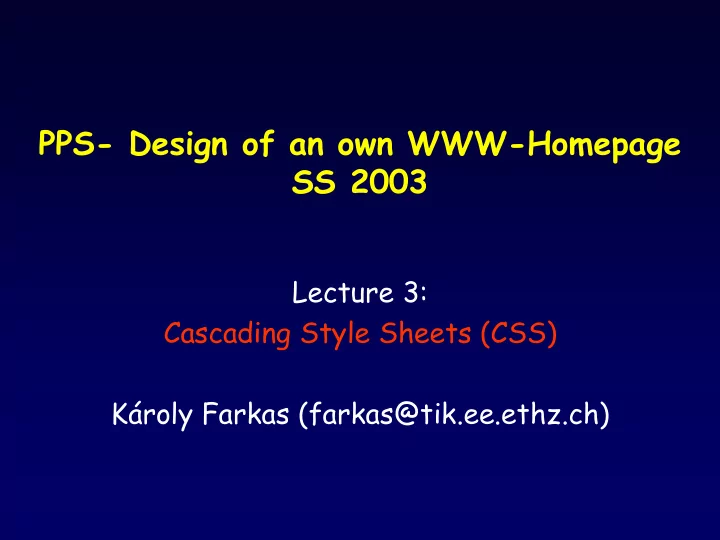

PPS- Design of an own WWW-Homepage SS 2003 Lecture 3: Cascading Style Sheets (CSS) Károly Farkas (farkas@tik.ee.ethz.ch)
Cascading Style Sheets Style sheets separate content from presentation • What can it do? – Allow authors and users to attach style to structured documents • Why? – Simplifies Web authoring and site maintenance • How? – Separate presentation style from content
Publishing with CSS Web Browser CSS CSS Style Sheet Style Sheet HTML Document Appearance
Attaching Style to Content • Embedded Style Sheet: STYLE element <HEAD> ... <STYLE type="text/css"> H1 { color: blue; font-size: 48pt } P { font-size: 32pt } </STYLE> ... </HEAD>
Attaching Style to Content (2) • External Style Sheets: LINK element <HEAD> ... <LINK rel="stylesheet" href="LINK-Element.css" type="text/css"> ... </HEAD>
Basics of CSS • A Style Sheet: – A set of rules which apply to an HTML document • Each rule consists of two parts: – Selector – Declaration Property Value P { color: green } Selector Declaration
CSS Rules’ Inheritance The rules specify which style declarations to be applied to which items in a document tree color: green color: red
Assignment 1 Create a dummy HTML page using Style Sheets. Hints: Download the 1 st example files and from the HTML file eliminate the Style related elements (move them into the .css file and add a reference to this file). Then change the property values in the style sheet file and observe the impact on the appearance of the HTML file.
Selectors • Type or Element selectors – refer to elements and some relationships between them • Attribute selectors – refer to element attributes and their values • Contextual selectors – refer to contextual relationship • External selectors – selection should be made on external information • Special selectors – define new elements with formatting semantics
Type/Element Selectors • Selects an Element according to its Type – Pattern: E or E1 + E2 or *, etc. P { color: green } or H1 { color: yellow } • It’s possible to use a grouping mechanism H1, H2, H3 { color: yellow }
Attribute Selectors • Simple attribute selectors – Pattern: [Attr] or E[Attr] • Attribute value selectors – Pattern: [Attr=“val”] or E[Attr=“val”] • Special attributes – Class selector: .Class or E.Class – ID selector: #ID or E#ID • Examples – See Assignment 2
Contextual Selectors • Uses Simple selectors (Type or Attribute) to specify a contextual relationship – Pattern: E1 E2 … LI P { margin-top: 0mm } or TABLE .SMALL P { font-size: small }
External Selectors • Selection should be made on external information • Pseudo Classes – Link Pseudo Classes • Pattern: :link|E:link or :active|E:active or :visited|E:visited A:link { color: green } • Pseudo Elements – First Letter, First Line • Pattern: :first-letter|E:first-letter or :first- line|E:first-line P:first-letter { font-size: 200% }
Special Selectors • Defines new elements with formatting semantics in HTML • Block-level element – Pattern: <DIV class|id=‘ value ’> … </DIV> • Inline element – Pattern: <SPAN class|id=‘ value ’> … </SPAN> • Examples – See Assignment 2
Declaration Block • Binds a value to a CSS property • Consists of a property name, followed by a colon, followed by a property value – Selector { Property1: Value1; Property2: Value2 } • Property names: – http://www.blooberry.com/indexdot/css/propind ex/all.htm • Values – Numbers (absolute, relative) – Percentage – Predefined aliases (e.g., small, bold, left, etc.)
Assignment 2 Study the files of example 2 then extend them to create an own HTML page using Style Sheets. Hints: - Use the on-line references given on the next slide. - Change the formatting style given in the example files. - Design an own Style Sheet and create an own HTML page based on this sheet using different headers, paragraphs, list elements, etc…
Further Information • CSS Home Page – http://www.w3.org/Style/CSS/ • CSS2 Specification – http://www.w3.org/TR/REC-CSS2/ • CSS On-line Tutorials – http://www.w3.org/Style/CSS/learning • CSS Tutorial (in German) – http://selfhtml.teamone.de/css/
Recommend
More recommend